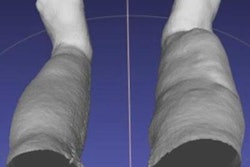
Coronary CT angiography (CCTA) studies may be complicated to interpret, but that doesn't mean radiologists can't use an iPad to remotely assess these exams for stenosis levels or to identify coronary anomalies, according to research published in the June issue of Emergency Radiology.
In a study involving 50 CCTA cases and two experienced readers, a team of researchers from Johns Hopkins University found no significant difference between interpretations performed on an iPad and those using a standard clinical 3D workstation.
"Remote reading with a tablet computer could be used to expand availability of coronary CTA in the [emergency department (ED)]," wrote the team led by Dr. Stefan Zimmerman.
A challenging read
CCTA has been shown to be a fast and accurate method for excluding significant coronary artery disease (CAD) in patients presenting to the emergency department with chest pain and low or intermediate risk for acute coronary syndrome. However, access to the exam may be limited to daytime and weekday hours, due in part to the availability of subspecialty trained physicians and the need for postprocessing workstations, according to the researchers (Emerg Radiol, June 2016, Vol. 23:3, pp. 255-261).
"Remote reading of coronary CTA studies could expand access by providing a platform for after-hour emergency department coverage on an as-needed basis without requiring imagers to be in-house," they wrote.
CCTA studies are challenging to read on tablets, however, due to the small size of the coronary arteries and the importance of interactively manipulating the imaging volume into reformatted planes. As a result, the researchers set out to compare the accuracy of interpretations of CCTA studies on an iPad with those on a standard clinical workstation.
In the retrospective study, two radiologists -- one with six years of experience and one with three years of experience -- separately interpreted 50 CCTA exams first on the iPad with Retina display using a dedicated 3D imaging application (syngo.via WebViewer version 2, Siemens Healthineers). The app enables users to manipulate the complete axial dataset via rotating, panning, zooming, and multiplanar reformatting functions, according to the team. Two weeks later, the same readers read the studies again using the institution's standard clinical workstation for interpreting CCTA studies.
The researchers noted that the best diastolic and/or systolic reconstructed phase as well as all multiphase reconstructions and multiplanar reformatted (MPR) and curved multiplanar reformatted (cMPR) images were available to the readers on both the iPad and the standard clinical workstation.
The readers scored the stenosis severity on a per-vessel basis. The five major coronary arteries were scored on a scale of 0 to 3:
- 0 = none
- 1 = mild (< 50%)
- 2 = moderate (≥ 50% to 69%)
- 3 = severe (≥ 70%)
In addition, the readers provided two scores for the maximal degree of stenosis for diagonal branches as a group and the obtuse marginal branches as a group. Scores of 0 or 1 were considered to be negative for clinically significant coronary artery disease, while scores of 2 or 3 were deemed to be positive. The readers also recorded the presence of any coronary artery anomalies or aneurysms.
The readers' scores on both workstation types were then compared with reference scores established by two other subspecialty trained cardiac radiologists in consensus. The 50 CCTA cases included six with severe CAD (score of 3), nine with moderate CAD (score of 2), 13 with mild disease (score of 1) in one or more vessels, and 22 with no CAD in any vessel. They also found seven coronary artery anomalies and one coronary artery aneurysm.
No significant difference
On both the iPad and the clinical workstation, the readers had 100% agreement with the reference standard for detecting coronary anomalies and the aneurysm. There also wasn't a statistically significant difference for per-vessel scores between the iPad and the clinical workstation:
- Overall agreement of per-vessel stenosis scores on iPad with reference standard: 74%
- Overall agreement of per-vessel stenosis scores on clinical workstation with reference standard: 76%
The researchers found similar, albeit higher, agreement levels for identifying the presence of significant CAD per vessel:
- Overall agreement for presence of significant CAD per vessel on iPad with reference standard: 87%
- Overall agreement for presence of significant CAD per vessel on clinical workstation with reference standard: 90%
The difference was also not statistically significant (p > 0.05).
Delving further into the data with multivariable logistic regression analysis, the group did not find any significant associations between the workstation type or reader and the reference standard.
Zimmerman and colleagues acknowledged a number of limitations of their study, including the use of reader consensus as a reference standard and a test cohort that included a higher number of patients with significant disease than is seen in typical clinical practice.
Nonetheless, the researchers concluded that CCTA using a "tablet computer is feasible with results that are no different from reading of cardiac exams on standard clinical workstations."




















